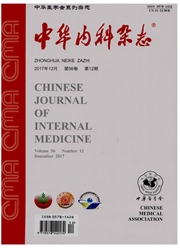

 中文摘要:
中文摘要:
目的 移植后淋巴细胞增殖性疾病(PTLD)是配型不相合造血干细胞移植(HSCT)患者严重并发症之一,本研究拟通过病例对照研究探讨单倍体相合HSCT后发生PTLD的危险因素.方法 在1 184例北京大学血液病研究所接受单倍体相合HSCT的患者中选取病理诊断为PTLD的12例患者作为PTLD组,采用巢式病例对照的方法,在同一队列中选取移植年限匹配的患者作为对照组(120例),分析与单倍体相合HSCT后PTLD发生相关的危险因素.结果 PTLD诊断的中位时间为移植后63.5(45 ~ 360)d.两组患者移植前特征、预处理方案及移植物组分的差异均无统计学意义.两组患者移植物抗宿主病和巨细胞病毒感染的比例相仿.移植后30 d,对照组CD19+细胞、CD3+细胞、CD4+细胞和CD8+细胞绝对值及血清IgG和IgM水平均明显高于PTLD组.多因素分析中,移植后30 d外周血CD4+细胞数绝对值低于0.019 9x10^9/L与PTLD的发生独立相关(OR =6.71,95%CI1.42 ~31.25,P=0.016),低危组(CD4+细胞数绝对值≥0.019 9x10^9/L,共66例)发生PTLD 2例(3.03%),高危组(CD4+细胞数绝对值<0.019 9x10^9/L,共66例)发生PTLD 10例(15.15%)(P=0.015).结论 移植后早期免疫重建不佳可能是单倍体相合HSCT患者发生PTLD的危险因素,改善移植后早期的免疫重建可能可以减少PTLD的发生.
 英文摘要:
英文摘要:
Objective Post-transplant lymphoproliferative disorder (PTLD) occurring after allogeneic hematopoietic stem cell transplantation (allo-HSCT) is rare but severe.Risk factors including pre-HSCT exposure variables,conditioning regimens,transplant-related complications,and post-HSCT immune reconstitution were investigated in the development of PTLD after allo-HSCT.Methods A nested case-controlled study was designed.Patients diagnosed with PTLD and controls match for time were identified from a cohort of 1 184 patients who underwent haploidentical HSCT between 2006 and 2012 for hematologic malignancies.Results There were 12 PTLD patients with median time to diagnosis 63.5 d (45-360 d) post-HSCT.The pre-HSCT exposure variables,conditioning regimens and transplant-related complications of the two groups had no statistical difference.Similar rates of graft versus host disease (GVHD) and cytomegalovirus (CMV) infection were seen in both groups.But the absolute count of CD19+ cells,CD3+ cells,CD4+ cells and CD8+ cells at day 30 after HSCT,the serum IgG and IgM were much higher in the control group.In multivariate analysis,absolute count of CD4+ cells lower than 0.019 9 x 10^9/L (OR=6.71,95%CI 1.42-31.25,P =0.016) at day 30 after HSCT was an independent risk factor for PTLD.Two cases (3.03 %) of PTLD occurred in the low risk group (absolute count of CD4+ cells ≥ 0.019 9 x 10^9/L),the other 10 cases (15.15%) in the high risk group (absolute count of CD4+ cells 〈0.019 9 x 10^9/L).Conclusions Patients with delayed immune reconstitution are at higher risk of developing PTLD after allo-HSCT.Improving the early immune reconstitution may help to decrease the incidence of PTLD after haploidentical HSCT.
 同期刊论文项目
同期刊论文项目
 同项目期刊论文
同项目期刊论文
 期刊信息
期刊信息
